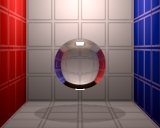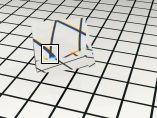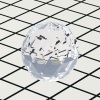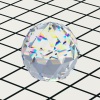

|
Advanced Rendering Toolkit
|
One of the key features of ART is the ability to use different colour representations for all internal calculations. The available representations at the moment are RGB, CIE XYZ and spectral representations with different numbers of evenly spaced samples: 8, 16, 45 and 450. The latter two correspond to 10 and 1 Nanometer samples through the visible spectrum.
One of the main areas where spectral colour representations offer an advantage over the tri-stimulus representations of RGB and CIE XYZ is the modelling of dispersion effects. Dispersion occurs in dieelectric (i.e. transparent) materials, and is a non-linear dependency of the refraction angle on the wavelength of the incident light. It is most commonly associated with the rainbow fringes and caustics that glass prisms and crystals produce.
ART can reproduce such effects accurately, although the computational cost for the proper (i.e. stochastic jittering) solution is significantly higher than for plain raytracing.


|
Comparison between images calculated without and with dispersion taken into account: a cut-out (enlarged in order to make the effect more visible) from a scene that contains a glass sphere in a box. Looking through the sphere, one sees the distorted surroundings; in optical systems, the coloured ring artifacts that are only present in the spectral version are normally highly undesirable. |
 



|
Raytracing dispersion effects: the test scene shows a prism floating over a textured table. The cut-outs (taken from the most prominent colour fringe in the image near the lower left corner of the prism) demonstrate the differences between different approaches. Samples 1 and 2 show the aliasing artifacts that are caused by naive raytracing with a fixed band spectral representation (with 8 and 16 bands, respectively). Enlargements 3 and 4 show the beneficial effects of stochastic jittering. In sample 3, one ray per pixel is used, while sample 4 was rendered with adaptive pixel subdivision (i.e. anti-aliasing). While sample 3 exhibits considerable noise, it is still a better rendering of the colour fringe than either samples 1 or 2. |

 |
Scene with a faceted lead crystal object, rendered without and with
dispersion effects. The crystal object is modeled after a decorative gem
produced by Swarovski which I happen
to have sitting on top of my monitor, and the dispersion charcteristics of lead crystal (and all other types of glass that they manufacture) can be found
on the homepage of Schott Glas in their
on-line glass catalog (a Windows application; to be found in the dowload
section).The dispersion image exhibits more colourful patterns than such objects normally do because the internal absorption of the glass was set to zero. This was done in order to better demonstrate the
ability of ART to reproduce colour gradients caused by dispersion even after nested interreflections. LogLuv versions of image 1 and image 2 are available. |